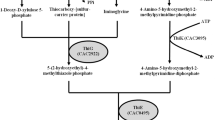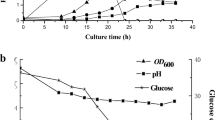Abstract
Cassava, due to its high starch content and low cost, is a promising candidate substrate for large-scale fermentation processes aimed at producing the solvents acetone, butanol and ethanol (ABE). However, the solvent yield from the fermentation of cassava reaches only 60% of that achieved by fermenting corn. We have found that the addition of ammonium acetate (CH3COONH4) to the cassava medium significantly promotes solvent production from cassava fermented by Clostridium acetobutylicum EA 2018, a mutant with a high butanol ratio. When cassava medium was supplemented with 30 mM ammonium acetate, the acetone, butanol and total solvent production reached 5.0, 13.0 and 19.4 g/l, respectively, after 48 h of fermentation. This level of solvent production is comparable to that obtained from corn medium. Both ammonium (NH4 +) and acetate (CH3COO−) were required for increased solvent synthesis. We also demonstrated substantially increased acetic and butyric acid accumulation during the acidogenesis phase as well as greater acid re-assimilation during the solventogenesis period in ammonium acetate-supplemented cassava medium. Reverse transcription-polymerase chain reaction analysis indicated that the transcription of several genes encoding enzymes related to acidogenesis and solventogenesis in C. acetobutylicum EA 2018 were enhanced by the addition of ammonium acetate to the cassava medium.





Similar content being viewed by others
References
Chen CK, Blaschek HP (1999) Acetate enhances solvent production and prevent degeneration in Clostridium beijerinckii BA101. Appl Microbiol Biotechnol 52:170–173
Chen CK, Blaschek HP (1999) Effect of acetate on molecular and physiological aspects of Clostridium beijerinckii NCIMB 8052 solvent production and strain degeneration. Appl Environ Microbiol 65:499–505
Chiao JS, Sun ZH (2007) History of the acetone–butanol–ethanol fermentation industry in China: development of continuous production technology. J Mol Microbiol Biotechnol 13:12–14
Cock JH (1982) Cassava: a basic energy source in the tropics. Science 218:755–762
Drummond GS, Smith EE, Whelan WJ, Tai H (1969) Mechanism of action of pullulanase. FEBS Lett 5:85–88
Dürre P (1998) New insights and novel developments in clostridial acetone/butanol/isopropanol fermentation. Appl Microbiol Biotechnol 49:639–648
El-Sharkawy MA (2004) Cassava biology and physiology. Plant Mol Biol 56:481–501
Ezeji TC, Groberg M, Qureshi N, Blaschek HP (2003) Continuous production of butanol from starch-based packing peanuts. Appl Biochem Biotechnol 105–108:375–382
Ezeji TC, Qureshi N, Blaschek HP (2004) Butanol fermentation research: upstream and downstream manipulations. Chem Rec 4:305–314
Ezeji T, Qureshi N, Blaschek HP (2007) Butanol production from agricultural residues: impact of degradation products on Clostridium beijerinckii growth and butanol fermentation. Biotechnol Bioeng 97:1460–1469
Jesse TW, Ezeji TC, Qureshi N, Blaschek HP (2002) Production of butanol from starch-based waste packing peanuts and agricultural waste. J Ind Microbiol Biotechnol 29:117–123
Jones DT, Woods DR (1986) Acetone–butanol fermentation revisited. Microbiol Rev 50:484–524
Karakashev D, Thomsen AB, Angelidaki I (2007) Anaerobic biotechnological approaches for production of liquid energy carriers from biomass. Biotechnol Lett 29:1005–1012
Kawano K (2003) Thirty years of cassava breeding for productivity—biological and social factors for success. Crop Sci 43:1325–1335
Ladisch MR (1991) Fermentation-derived butanol and scenarios for its uses in energy-related applications. Enzyme Microb Technol 13:280–283
Lu YH, Wang WH, Shu D, Zhang WW, Chen L, Qin ZJ, Yang S, Jiang WH (2007) Characterization of a novel two-component regulatory system involved in the regulation of both actinorhodin and a type I polyketide in Streptomyces coelicolor. Appl Microbiol Biotechnol 77:625–635
Nolling J, Breton G, Omelchenko MV, Makarova KS, Zeng Q, Gibson R, Lee HM, Dubois J, Qiu D, Hitti J, Wolf YI, Tatusov RL, Sabathe F, Doucette-Stamm L, Soucaille P, Daly MJ, Bennett GN, Koonin EV, Smith DR (2001) Genome sequence and comparative analysis of the solvent-producing bacterium Clostridium acetobutylicum. J Bacteriol 183:4823–4838
Qureshi N, Blaschek HP (2001) Recent advances in ABE fermentation: hyper-butanol producing Clostridium beijerinckii BA101. J Ind Microbiol Biotechnol 27:287–291
Qureshi N, Li XL, Hughes S, Saha BC, Cotta MA (2006) Butanol production from corn fiber xylan using Clostridium acetobutylicum. Biotechnol Prog 22:673–680
Qureshi N, Lolas A, Blaschek HP (2001) Soy molasses as fermentation substrate for production of butanol using Clostridium beijerinckii BA101. J Ind Microbiol Biotechnol 26:290–295
Ryan SM, Fitzgerald GF, van Sinderen D (2006) Screening for and identification of starch-, amylopectin-, and pullulan-degrading activities in bifidobacterial strains. Appl Environ Microbiol 72:5289–5296
Sauer U, Dürre P (1995) Differential induction of genes related to solvent formation during the shift from acidogenesis to solventogenesis in continuous culture of Clostridium acetobutylicum. FEMS Microbiol Lett 125:115–120
Wiesenborn DP, Rudolph FB, Papoutsakis ET (1988) Thiolase from Clostridium acetobutylicum ATCC 824 and its role in the synthesis of acids and solvents. Appl Environ Microbiol 54:2717–2722
Zhang YF, Chen J, Yang YL, Jiao RS (1996) Breeding high-ration butanol strains of Clostridium acetobutylicum and application to industrial production. Ind Microbiol 26:1–6
Zverlov VV, Berezina O, Velikodvorskaya GA, Schwarz WH (2006) Bacterial acetone and butanol production by industrial fermentation in the Soviet Union: use of hydrolyzed agricultural waste for biorefinery. Appl Microbiol Biotechnol 71:587–597
Acknowledgments
We are grateful to Prof. Peng Zhang, Dr. Jiping Shi and Mr. Zhaobing Shen for their helpful suggestions and for providing cassava. We thank Dr. Wenping Wu for providing pullulanase and Dr. Weiwen Zhang for editing the text. This work was supported by the National Basic Research Program of China (973: 2007CB707803), the National High-tech Research and Development Program of China (863: 2006AA02Z237; 863: 2007AA05Z407) and the Knowledge Innovation Program of the Chinese Academy of Sciences (KSCX2-YW-G-007).
Author information
Authors and Affiliations
Corresponding authors
Rights and permissions
About this article
Cite this article
Gu, Y., Hu, S., Chen, J. et al. Ammonium acetate enhances solvent production by Clostridium acetobutylicum EA 2018 using cassava as a fermentation medium. J Ind Microbiol Biotechnol 36, 1225–1232 (2009). https://doi.org/10.1007/s10295-009-0604-1
Received:
Accepted:
Published:
Issue Date:
DOI: https://doi.org/10.1007/s10295-009-0604-1




